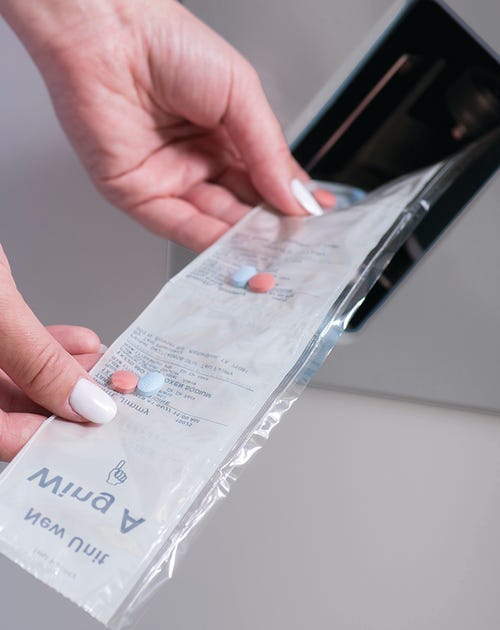Long-term Care Providers Adjust to Hazardous Pharmaceutical Waste Rule
Long-term care providers, who were once exempt from the hazardous pharmaceutical waste regulations, now have very specific requirements.

The U.S. Environmental Protection Agency’s (EPA) final rule on hazardous pharmaceutical waste management will present a steep learning curve for long-term care facilities.
Until the August 2019 ruling, which among provisions prohibits flushing or pouring certain pharmaceuticals down the drain, long-term care providers were exempt from the hazardous pharmaceutical waste regulations. Now, they have very specific requirements, though those requirements will depend on which of two options they elect that EPA laid out for them.
Long-term care operations are defined as nursing facilities, skilled nursing facilities, skilled and nursing care parts of a life plan community and hospice. One option these providers now have is to weigh their hazardous pharmaceutical waste and document volume. Facilities that produce less than 1 kilogram (kg) per month of acute hazardous waste (as defined by EPA on its P list) will be required to do less training in managing them. And overall, these “very small quantity waste generators” are subject to less-stringent requirements.
Then comes the second option.
“Long-term care providers can choose not to weigh and document, which can be onerous processes. But if they choose this option, they must register with the EPA under subpart P of RCRA [Resource Conservation and Recovery Act] as healthcare facilities. [In this second scenario], they can keep the pharmaceuticals onsite—regardless of how much they generate. But they must provide training and have a more expansive management program,” explains Jennifer Hardesty, pharmacist and chief clinical officer of Remedi SeniorCare. Remedi provides medication management services for long-term care facilities.
“Now, long-term care facilities have to do something for the first time, but they can choose from two paths,” Hardesty says.

California Law SB 212
Meanwhile, these generators struggle to identify what’s hazardous and to know exactly how to manage it. To help the nursing staff, Remedi labels product packaging or prints on medication bags to identify drugs that EPA deems as hazardous.
While labeling helps, there must be a process to manage the drugs, but developing such processes has been among the greatest challenges.
“Long-term care operations are looking for waste management vendors for guidance, and these vendors don’t all have the same approach. Facilities need education, and they need waste companies to explain concepts and offer solutions,” says Hardesty.
Unusable drugs accumulate, as do associated costs. A report from five years ago shows long-term care facilities in the U.S. wasted $2 billion in unexpired medicines annually.
Among complexities in preventing waste is that the average skilled nursing facility patient takes 13.5 medications a day. Meanwhile, orders change, often before the preset quantity is consumed, says Huan K. Nguyen, vice president of long-term care business development for Swisslog Healthcare. Swisslog is one of a few companies that sells an automated medication packaging system that only packages about a day’s supply at a time and dispenses on demand, meaning the exact dose and at the time it’s needed.
“This not only reduces waste but eliminates the need for time-consuming tasks such as documenting processes like storage and destruction of medication. And it eliminates the need for the destruction to be witnessed in cases where that would be required,” says Nguyen.
Francis Rubino, director of pharmacy at Friendship Pharmacy in Philadelphia, uses Swisslog’s automated system to service his long-term care clients and says it helps.

“While some pharmacies dispense every three days, most dispense in seven- to 28-day intervals. If an order changes, you could potentially waste 27 days of medications. But with this system, you might waste none, or at the most, you waste one day of medications or even one dose,” says Rubino.
For now, long-term care facilities should stop flushing and pouring pharmaceuticals down drains, advises Elise Paeffgen, partner at health and environmental law firm Alston & Bird.
“They should carefully track state implementation of the new requirements. And if they are a very small quantity generator, they should decide whether to manage their hazardous waste pharmaceuticals under the new management standards [where they would not have to weigh the quantity] or whether to manage under the RCRA very small generator requirements. Once this key decision is made, skilled nursing facilities need to map out how the standards apply to their operations, develop a management plan and train their staff,” says Paeffgen.
ProMedica HCR ManorCare has 171 skilled nursing facilities in 17 states. Complying can be confusing since each state can develop its own requirements if they are at least as stringent as the federal rule, says Greg Milanich, assistant vice president of pharmacy services for HCR ManorCare.
“States like Colorado have had stricter requirements for a few years, so we face more restrictions there. For instance, we can’t commingle, so we have one container for EPA’s P-listed medications [acutely hazardous] and another for the U [universal] waste. We need the states to adopt the EPA standards or develop their own, and we are waiting on this now,” says Milanich.
He says partnerships with pharmacies and with waste management vendors will be important, too.
“We rely on pharmacies to help identify medications. And we rely on waste management vendors to come up with a process to properly dispose of pharmaceutical waste,” adds Milanich.
About the Author(s)
You May Also Like




